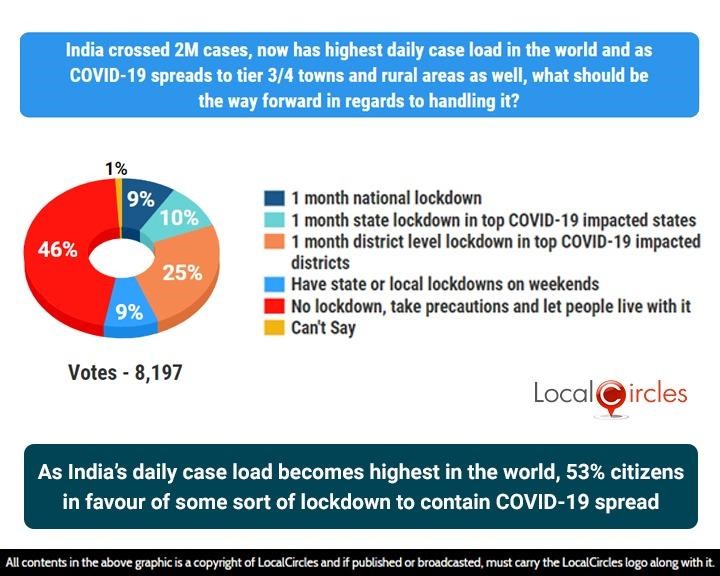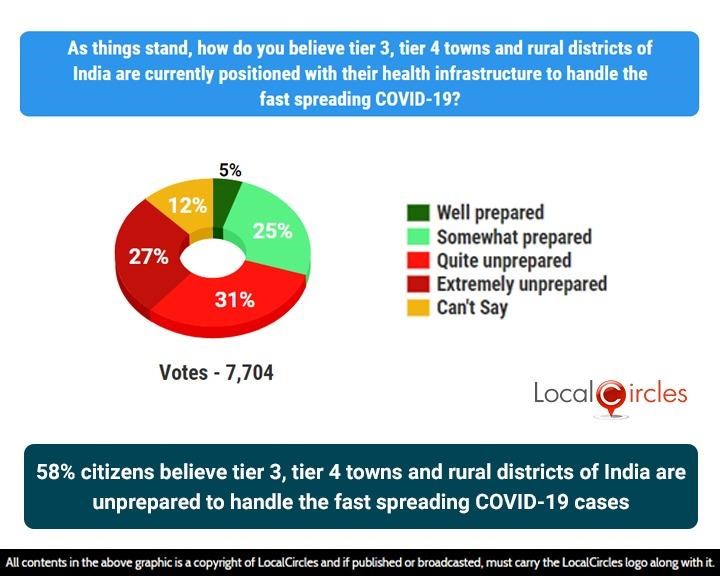As India’s COVID-19 daily case load becomes highest in the world 58% citizens believe small towns and rural districts unprepared to handle the pandemic
- • With 1000+ cases in 372 districts, citizens fear the remaining 50% districts may also get impacted
- • 53% citizens still in favour of some sort of lockdown to contain COVID-19 spread
August 19, 2020, New Delhi: After USA and Brazil, India became the third country to cross 2.5 million cases of COVID-19, and now has highest daily case load in the world with over 60,000 cases being reported each day for the last 7 days. On 13th August, India recorded its biggest single day spike of over 66,000 COVID positive cases, making India the country with the fastest Coronavirus growth rate. The total number of districts with 1,000 or more COVID-19 cases has increased to 372 as compared to 104 just a month ago and 20 on May 17th when India started relaxing the lockdown.
LocalCircles conducted a survey to get the collective pulse of people of India on how the Government should proceed with handling the situation. The 3-poll survey received over 24,000 votes from 242 districts of the country.
In the first question, citizens were asked as COVID-19 spreads to tier 3/4 towns and rural areas as well, what should be the way forward with regards to handling it. In response, 9% said there should be a 1-month national lockdown, and 10% said there should be a 1-month state lockdown in top COVID-19 impacted states. 25% said there should be a 1-month district level lockdown in top COVID-19 impacted districts while 9% said there should be state or local lockdowns on weekends. 46% said there should be no lockdown, precautions should be taken, and people should learn to live with it.
As India’s daily case load becomes highest in the world, 53% citizens in favour of some sort of lockdown to contain COVID-19 spread

This means that as India’s daily case load becomes highest in the world, 53% citizens in favour of some sort of lockdown to contain COVID-19 spread. The last 1 million cases in India took only 20 days, which surprisingly is faster than both USA which took 43 days and Brazil which took 27 days. Although the centre has been slowly unlocking the economy, some states have decided to reimpose certain restrictions – for example gyms across the country were allowed to open recently but looking at the situation, the Delhi Government decided to keep them shut for a few more weeks.
The next question asked citizens if the Government does not decide to lockdown at national, state or district levels and instead follows the living with COVID-19 model, what will be the approach they will personally take when it comes to going out in the next 90 days. 4% said they will go out to malls, markets, public places like pre-COVID days, 47% said they will go out only for essential needs and work, 34% said they will go out only for critical needs and work, while 14% said they will not go out at all and order products/services to come home.
85% citizens say if lockdowns aren’t in place at national, state or local levels in the next 90 days, they plan to step out for critical and essential needs and works

The results of this poll indicate that around 85% citizens say if lockdowns aren’t in place at national, state or local levels, they will go out for whey they deem as critical or essential works with a small percentage even going out for leisurely activities in the next 90 days.
Health infrastructure continues to be a major challenge in tier 3, tier 4 towns and rural areas of India with many just having a district hospital functioning as a quarantine center. If any critical cases are found, majority of these districts do not have the capability of handling a COVID-19 case. The patient then has to be transported to the nearest tier 2 or tier 3 town which typically has atleast a few hospitals treating COVID-19 cases. However, for many such facilities are atleast several hundred kilometers away and ambulances to transport then aren’t necessarily available given the pandemic.
58% citizens believe tier 3, tier 4 towns and rural districts of India are unprepared to handle the fast spreading COVID-19 cases

The final question asked citizens as things stand, how do they believe tier 3, tier 4 towns and rural districts of India are currently positioned with their health infrastructure to handle the fast spreading COVID-19. Only 5% said they were well prepared while 25% said they were somewhat prepared. 31% said they were quite unprepared while 27% said they were extremely unprepared.
This shows that 58% citizens believe tier 3, tier 4 towns and rural districts of India are unprepared to handle the fast spreading COVID-19 cases. India has ramped up its COVID-19 testing infrastructure and has conducted over 2 crore COVID-19 tests. The country has also been testing comparatively more in the recent weeks with the number of testing labs increasing from 1 in January to 1370 currently. The Government is saying although the daily number of COVID-19 cases are increasing, the numbers of daily recoveries are also rising steadily.
The challenge however remains that with 372 districts already having 1000+ cases, as COVID-19 case load increases in the other 364 districts that are largely tier 4 or rural, the critical patients may not be able to find the needed healthcare. The other risk that exists is that as COVID-19 spreads in rural India and many patients visit nearby towns and big cities for treatment, it could worsen the situation in these places with what people are calling as the second wave of COVID-19 cases.
Many citizens via LocalCircles have been expressing their concern that India entered the lockdown too soon and exited it too soon as compared to most nations around the world and that there is need for additional lockdowns if India wants to contain the spread. This sentiment is now being expressed by many experts as well. Nobel laureate Abhijit Banerjee recently said that Indian entered the lockdown too soon and exited too soon, and that there might be a need for further lockdown in the severely affected areas. India might have one of the lowest deaths per million people compared to many countries currently, but clearly the citizens believe that the next explosion of cases could be from rural India, which is not well prepared to handle this pandemic.
Survey Demographics
24,000+ responses were received across 242 districts of India. 65% respondents were men while 35% respondents were women. 44% respondents were from tier 1, 25% from tier 2 and 31% respondents were from tier 3, 4 and rural districts. They survey was conducted via LocalCircles platform and all participants are validated citizens who had to be registered with LocalCircles to participate in this survey.
About LocalCircles
LocalCircles, India’s leading Community Social Media platform enables citizens and small businesses to escalate issues for policy and enforcement interventions and enables Government to make policies that are citizen and small business centric. LocalCircles is also India’s # 1 pollster on issues of governance, public and consumer interest. More about LocalCircles can be found on https://www.localcircles.com
Akshay Gupta - media@localcircles.com, +91-8585909866
All content in this report is a copyright of LocalCircles. Any reproduction or redistribution of the graphics or the data therein requires the LocalCircles logo to be carried along with it. In case any violation is observed LocalCircles reserves the right to take legal action.


